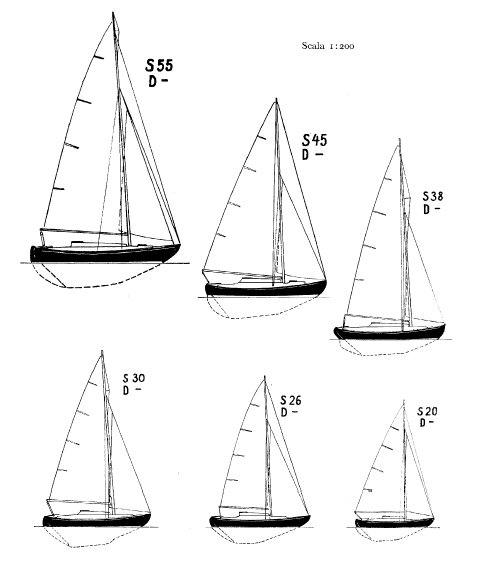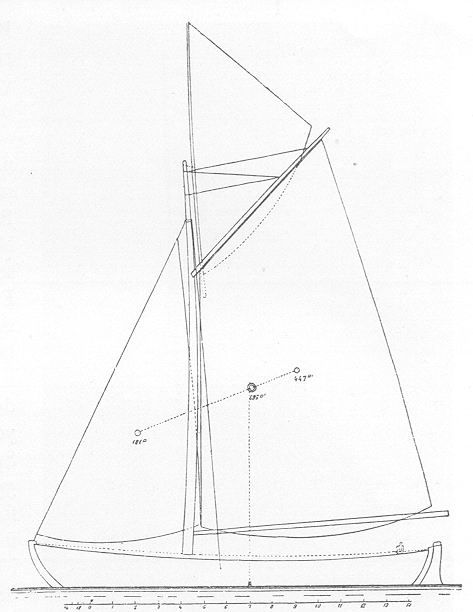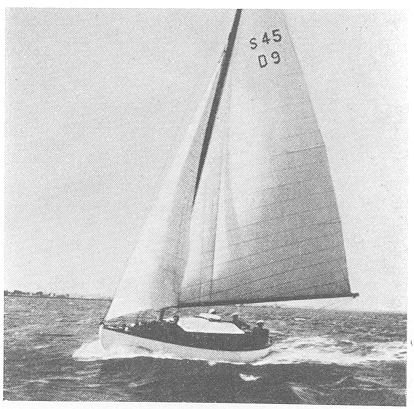|
|
Home |
|
* * * * |
Spidsgatters (Danish for class of double-enders) |
|
|
The following account is inspired by the Danish book Hvide Sejl. Class overview; 55 m2; 45m2; 38 m2; 30 m2 The spidsgatter has experienced a unique succes. Its hull and shape is, by and large akin to that of the Øresunds-Kragejolle - refined but not always implying greater beauty. It is undercut in its stem, has a iron or lead external keel, and is almost alway carvel built with a bermuda rig. Its proponents praise it for its sea-going ability and ample space below deck [...] and it has become the most popular boat in the country. Already in 1914, the first of the Spidsgatters, as we know them today, emerged. It was Kulling, a 30 m2 boat with a strong undercut stempost. The rig was very high, with a narrow gaf and boom. It was designed by Berg, who later designed the 40 m2 Pan and the 65 m2 Ørn. The number of Spidsgatters grew at a steady rate and other constructors contributed. In 1918 Utzon designed a 55 m2 Spidsgatter (four new builds were done based on the Utzon design of which the Shamrock was the most succesful one). There was a great interest for the Spidsgatters - specially outside of the capital, Copenhagen. But racing these boats was difficult due to them being different in design, construction, and scantlings. Utzon had for a long time argued for a class Spidsgatter and finally in the late 1920s, the local sailing union (in Jylland) held a competition for a 30 m2 and a 45 m2 (more types emerged later). Utzon won a first prize for the 45 m2 and Berg for the 30 m2. Utzon and Berg - together with Hansen - were to become the three great Danish Spidsgatter designer. Which of them was the best can even today trigger discussion among connoisseurs (but only among those, mind you). A rules set was made for the new-born classes but attempts to include Sweden and Norway did not succeed (they went for double-enders of more narrow beams and cannoe sterns) and so the Spidsgatter became a national Danish class. Interestingly, the scantlings for the classes were explicitly concerned with keeping prices down. For instance, it was stipulated that only Scandinavian wood was allowed, and hollow spars were not allowed. This, combined with the Spidsgatters ample space below decks and its relatively fine sailing capabilities, ensured its success. It was cheap to build and any able ship yard, which in these days were scattered all around the country busy with building fishing boats, would be able to build one since the techniques were similar to those employed on the fishing vessels. The Spidsgatter was the first boat to reach those persons who wanted to cruise and race but did not have the money to engage in the prohibitively costly affair it was to "run" a meter boat. The question of the Spidsgatters sailing abilities has been widely discussed. For many years, the Spidsgatter was regarded as "less" of a boat than for instance the cutters with their large overhangs. Arguably, the Spidsgatter's plumb stern did not convey the same impression of elegance as that of the English heritage cutter. But whether or not one likes the stern of the Spidsgatter is a matter of taste. Proponents points to the stern's superior ability to fend off running seas whereas others dislike its (alledged) drag. The Spidsgatter's bow is distinctly more voluminious than the cutter's. For the former this means a relatively more bumpy, but dry, ride, whereas for the latter, it tends to cut through the waves. Today, Spidsgatters are a common sight in Danish waters. Ironically, they tend to be centered around the Copenhagen area that for so long persisted the development towards cheap boats for the common man. Also, relatively many Spidsgatters were exported to the US and Canada. A new range of double-ended class-boats have evolved from the Spidsgatters - notably the so called Spækhugger and its bigger sisterships, the Grinde and the Kaskelot. A comment on a few class SpidsgattersUndine is probably one of the best kept wooden boats of the world - and certainly the best kept 55 sqm Spidsgatter. The story goes that the previous owner, each winter, drilled a large number of small holes in strategically important places and, via cotton wicks, let the wood soak as much fungis killing substances, linseed oil etc as it possibly could. The mast runs 18 m high in the air. It is today in very fine shape and has recently been fitted with a new deck by its owner (a wooden boat builder) who convinced the older owner to sell it to him.
|
   |
|